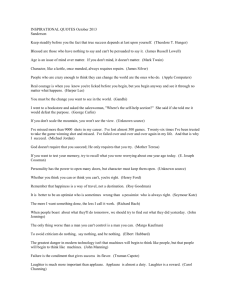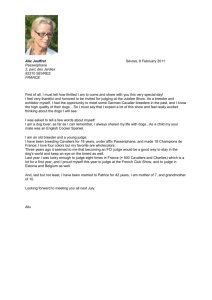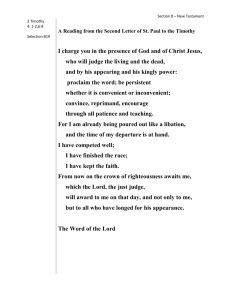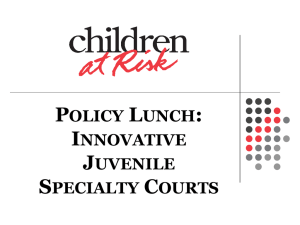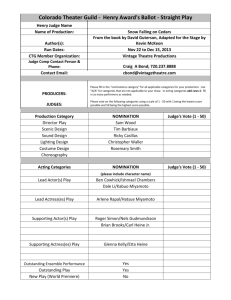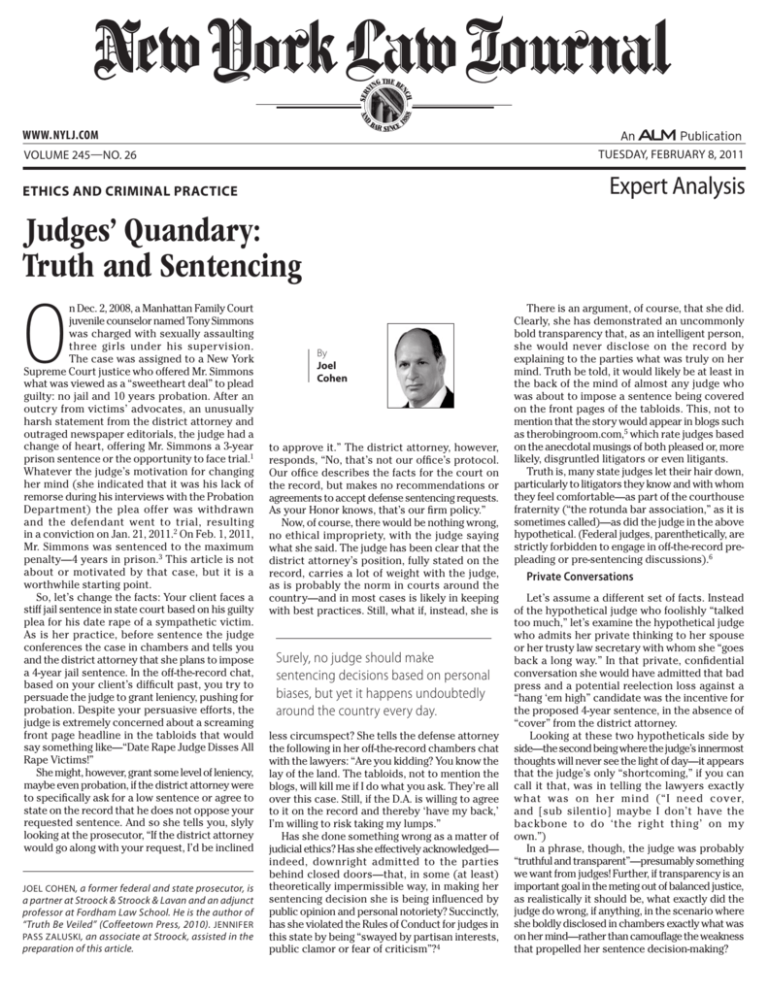
AND
88
8
SER
V
H
NC
THE BE
ING
1
BA
R SINCE
www. NYLJ.com
tuesday, february 8, 2011
Volume 245—NO. 26
Expert Analysis
ethics and criminal practice
Judges’ Quandary:
Truth and Sentencing
O
n Dec. 2, 2008, a Manhattan Family Court
juvenile counselor named Tony Simmons
was charged with sexually assaulting
three girls under his supervision.
The case was assigned to a New York
Supreme Court justice who offered Mr. Simmons
what was viewed as a “sweetheart deal” to plead
guilty: no jail and 10 years probation. After an
outcry from victims’ advocates, an unusually
harsh statement from the district attorney and
outraged newspaper editorials, the judge had a
change of heart, offering Mr. Simmons a 3-year
prison sentence or the opportunity to face trial.1
Whatever the judge’s motivation for changing
her mind (she indicated that it was his lack of
remorse during his interviews with the Probation
Department) the plea offer was withdrawn
and the defendant went to trial, resulting
in a conviction on Jan. 21, 2011.2 On Feb. 1, 2011,
Mr. Simmons was sentenced to the maximum
penalty—4 years in prison.3 This article is not
about or motivated by that case, but it is a
worthwhile starting point.
So, let’s change the facts: Your client faces a
stiff jail sentence in state court based on his guilty
plea for his date rape of a sympathetic victim.
As is her practice, before sentence the judge
conferences the case in chambers and tells you
and the district attorney that she plans to impose
a 4-year jail sentence. In the off-the-record chat,
based on your client’s difficult past, you try to
persuade the judge to grant leniency, pushing for
probation. Despite your persuasive efforts, the
judge is extremely concerned about a screaming
front page headline in the tabloids that would
say something like—“Date Rape Judge Disses All
Rape Victims!”
She might, however, grant some level of leniency,
maybe even probation, if the district attorney were
to specifically ask for a low sentence or agree to
state on the record that he does not oppose your
requested sentence. And so she tells you, slyly
looking at the prosecutor, “If the district attorney
would go along with your request, I’d be inclined
Joel Cohen, a former federal and state prosecutor, is
a partner at Stroock & Stroock & Lavan and an adjunct
professor at Fordham Law School. He is the author of
“Truth Be Veiled” (Coffeetown Press, 2010). Jennifer
Pass Zaluski , an associate at Stroock, assisted in the
preparation of this article.
By
Joel
Cohen
to approve it.” The district attorney, however,
responds, “No, that’s not our office’s protocol.
Our office describes the facts for the court on
the record, but makes no recommendations or
agreements to accept defense sentencing requests.
As your Honor knows, that’s our firm policy.”
Now, of course, there would be nothing wrong,
no ethical impropriety, with the judge saying
what she said. The judge has been clear that the
district attorney’s position, fully stated on the
record, carries a lot of weight with the judge,
as is probably the norm in courts around the
country—and in most cases is likely in keeping
with best practices. Still, what if, instead, she is
Surely, no judge should make
sentencing decisions based on personal
biases, but yet it happens undoubtedly
around the country every day.
less circumspect? She tells the defense attorney
the following in her off-the-record chambers chat
with the lawyers: “Are you kidding? You know the
lay of the land. The tabloids, not to mention the
blogs, will kill me if I do what you ask. They’re all
over this case. Still, if the D.A. is willing to agree
to it on the record and thereby ‘have my back,’
I’m willing to risk taking my lumps.”
Has she done something wrong as a matter of
judicial ethics? Has she effectively acknowledged—
indeed, downright admitted to the parties
behind closed doors—that, in some (at least)
theoretically impermissible way, in making her
sentencing decision she is being influenced by
public opinion and personal notoriety? Succinctly,
has she violated the Rules of Conduct for judges in
this state by being “swayed by partisan interests,
public clamor or fear of criticism”?4
There is an argument, of course, that she did.
Clearly, she has demonstrated an uncommonly
bold transparency that, as an intelligent person,
she would never disclose on the record by
explaining to the parties what was truly on her
mind. Truth be told, it would likely be at least in
the back of the mind of almost any judge who
was about to impose a sentence being covered
on the front pages of the tabloids. This, not to
mention that the story would appear in blogs such
as therobingroom.com,5 which rate judges based
on the anecdotal musings of both pleased or, more
likely, disgruntled litigators or even litigants.
Truth is, many state judges let their hair down,
particularly to litigators they know and with whom
they feel comfortable—as part of the courthouse
fraternity (“the rotunda bar association,” as it is
sometimes called)—as did the judge in the above
hypothetical. (Federal judges, parenthetically, are
strictly forbidden to engage in off-the-record prepleading or pre-sentencing discussions).6
Private Conversations
Let’s assume a different set of facts. Instead
of the hypothetical judge who foolishly “talked
too much,” let’s examine the hypothetical judge
who admits her private thinking to her spouse
or her trusty law secretary with whom she “goes
back a long way.” In that private, confidential
conversation she would have admitted that bad
press and a potential reelection loss against a
“hang ‘em high” candidate was the incentive for
the proposed 4-year sentence, in the absence of
“cover” from the district attorney.
Looking at these two hypotheticals side by
side—the second being where the judge’s innermost
thoughts will never see the light of day—it appears
that the judge’s only “shortcoming,” if you can
call it that, was in telling the lawyers exactly
what was on her mind (“I need cover,
and [sub silentio] maybe I don’t have the
backbone to do ‘the right thing’ on my
own.”)
In a phrase, though, the judge was probably
“truthful and transparent”—presumably something
we want from judges! Further, if transparency is an
important goal in the meting out of balanced justice,
as realistically it should be, what exactly did the
judge do wrong, if anything, in the scenario where
she boldly disclosed in chambers exactly what was
on her mind—rather than camouflage the weakness
that propelled her sentence decision-making?
tuesday, february 8, 2011
Televangelist Bakker’s Case
Of course, we don’t want judges to make
decisions based on impermissible considerations—
for example, race, ethnicity, gender or national
origin. Famously, in 1989, federal District Judge
Robert ( “Maximum Bob”)7 Potter in Charlotte,
N.C., sentenced televangelist Jim Bakker to 45
years in jail for fraud. He did so, though, after
making scathing remarks on the record to Mr.
Bakker as having given “no thought…[to] those
of us who do have a religion [being] ridiculed
as being saps from money grubbing preachers
or priests.”8
The U.S. Court of Appeals for the Fourth Circuit
reversed the sentence, holding that courts cannot
sanction sentencing procedures “that create
the perception of the bench as a pulpit from
which judges announce their personal sense of
religiosity and simultaneously punish defendants
for offending it.”9 This resulted, finally, on remand,
in a significant sentencing reduction—an 18-year
sentence for Mr. Bakker imposed by a different
district judge (and later, actually a further
reduction to 8 years).10
In imposing the initial sentence and highlighting
his personal (clearly biased) feelings about Mr.
Bakker and other similar preachers, Judge Potter
betrayed the inner workings of his mind. Notably,
the Fourth Circuit said, “as the community’s
spokesman, a judge can lecture a defendant as
a lesson to that defendant and as a deterrent to
others.”11 Meaning, had Judge Potter stopped
there, the court probably would not have reversed
the same 45-year sentence—which presumably
would have been based on the same improper
considerations that Judge Potter articulated,
i.e., his perception about the “money grubbing
preachers” that, at least to Judge Potter, Mr. Bakker
personified.
Surely, no judge should make sentencing
decisions based on personal biases, but yet it
happens undoubtedly around the country every
day. Indeed, Justice Benjamin Cardozo famously
taught us that: “All their lives, forces which
[judges] do not recognize and cannot name,
have been tugging at them—inherited instincts,
traditional beliefs, acquired convictions…We may
try to see things as objectively as we please. None
the less, we can never see them with any eyes
except our own.”12
Still, in some way, isn’t it preferable that Judge
Potter (honestly) articulated his thought process
at sentencing, even as questionable as it was? For
when anyone, especially a judge, tells you what
(s)he is truly thinking, isn’t there a greater chance
that the able lawyer is better equipped to respond
to the judge’s concerns head on to try to make
persuasive arguments which the litigator hopes
would provide an antidote to the judge’s thinking?
Had Judge Potter kept his innermost (indeed,
biased) beliefs to himself and nonetheless
imposed the same sentence that was a legal
(pre-Guidelines) sentence, Jim Bakker (rightly
or wrongly) would still be sitting in prison—no
reversal, no reassignment, no new sentence
ab initio.
Other Examples
There are, of course, other examples where a
judge’s transparent thinking has been the cause
of appellate reversals, but are not viewed as
ethical violations. For example, one district judge
in the U.S. Court of Appeals for the Second
Circuit has had a number of circuit reversals
that stemmed from his idiosyncratic view
that, when the defense seeks a downward
departure from sentencing guidelines (a Rule
5K1.1 motion),13 the failure by the prosecutor to
provide a specific sentencing recommendation
should result in the court granting no departure
whatsoever.
Since no law or case requires the prosecutor to
make a specific recommendation for a sentence
reduction, several of this judge’s sentencing
decisions have been reversed.14 On occasion, in fact,
the circuit court remanded the district judge’s case
to a different judge after the court vacated lengthy
sentences that gave the defendants no sentencing
benefits for their significant cooperation. Obviously,
this judge, unlike the judge in the hypothetical that
began this article, has been willing to go on the
record and “truthfully” state the “bias” that has
guided him—albeit, according to the Second Circuit,
erroneously.
Jim Bakker’s result is a classic. Had Judge
Potter or the district judge mentioned above
kept their motivating views to themselves, all of
those defendants would have been far the worse
for it. It seems that particularly in a new age of
transparency, we should want our judges to tell us
exactly what is on their minds, rightly or wrongly,
when they have our clients’ fates in their hands.
Indeed, if they introspectively recognize that they
are indeed being “swayed by partisan interests,
public clamor or fear of public criticism,”18 as
verboten by the Rules of Conduct, perhaps we
put them in the untenable position of engaging in
opaque silence when they articulate on the record
their reasons for their sentencing decisions.
Stated more forcefully, perhaps we need to
rethink the judicial ethic that basically insists that
judges sometimes engage in a certain amount of
deceptiveness on the record, lest they appear
to communicate that they are influenced by
ostensibly impermissible considerations. It might
actually do Justice Cardozo proud!
•••••••••••••
If transparency is an important goal in
the meting out of balanced justice, as
realistically it should be, what exactly
did the judge do wrong, if anything, in
the scenario where she boldly disclosed
in chambers exactly what was on
her mind?
The advantage of the judge’s candor? The
defendants’ lawyers were able to gain reversals.
Had he, instead, simply rejected the cooperation
in these cases as being insufficient to warrant
significant departures or, perhaps, even departed
downward minimally as a token compliance
with law, the defendants would likely have been
largely out of luck. They would continue to serve
lengthy sentences that probably would have been
unwarranted given their admittedly “substantial
assistance”15 to the government.
Interestingly, on Jan. 28, the Second Circuit
reversed a sentence imposed on a defendant who
had pled guilty to a child pornography offense.16
There, the district judge had extensively discussed
at sentence the defendant’s “predisposition” to
reoffend, saying that the defendant had a “gene
that you were born with, and it’s not a gene that
you can get rid of.” For the circuit, the judge’s
stated views required remand to a different judge,
given that “the judge’s fairness or the appearance
of the judge’s fairness is seriously in doubt.”17
Indeed, the judge was candid about his views on
the record, even though his view was probably
unsound as a matter of genetics—but, as pertinent
here, the judge’s “truthful” statement of his views
undoubtedly helped gain the sentence reversal
and remand to a more “objective” judge.
This is not intended to suggest that a judge’s
practice, which may be legally wrong, is acceptable
merely because he makes a record of his view of
what should be proper practice, even if he knows
the law or facts to be to the contrary. Rather, it
is far better for the record to reflect the judge’s
true motivations and thinking, better enabling
the lawyer to address it either before that judge
himself or on appeal.
••••••••••••••••
1. See Tim Stelloh, “Judge Withdraws Plea Deal for Probation
in a Rape Case,” N.Y. Times, Nov. 15, 2010, at A26.
2. See John Eligon, “No-Prison Deal Revoked, Trial Starts for
Ex-City Worker Accused in Sexual Assault of Girls,” N.Y. Times,
Jan. 13, 2011, at A20; John Eligon, “Juvenile Justice Counselor
Is Guilty of Sexual Assault,” N.Y. Times, Jan. 22, 2011, at A16.
3. See John Eligon, “Court Counselor Sentenced to Four
Years for Sex Assaults,” CITY ROOM, N.Y. TIMES, Feb.
1,
2011,
http://cityroom.blogs.nytimes.com/2011/02/01/
family-court-counselor-sentenced-to-four-years-for-sexassaults/?ref=nyregion.
4 . See 22 NYCRR §100.3(B)(1) (“A judge shall be faithful to
the law and maintain professional competence in it. A judge
shall not be swayed by partisan interests, public clamor or
fear of criticism.”)
5. The Robing Room, http://www.therobingroom.com (last
visited Jan. 19, 2011).
6. Fed. R. Crim Pro. 11(c) (“An attorney for the government
and the defendant’s attorney, or the defendant when
proceeding pro se, may discuss and reach a plea agreement.
The court must not participate in these discussions….”)
7. See Alain L. Sanders et al., Law: “The Wrath of Maximum
Bob,” Time Magazine, Nov. 06, 1989, http://www.time.com/
time/magazine/article/0,9171,958966,00.html.
8. U.S. v. Bakker, 925 F.2d 728, 740 (4th Cir. 1991).
9. Id.
10. See “Bakker’s Sentence Cut to 8 years; Parole Possible
in 1 Year,” Orlando Sentinel, Dec. 23, 1992, at A6. The article
notes that Bakker parole date was ultimately reduced even
further—to 8 years—in 1992.
11. Bakker at 740.
12. “Benjamin N. Cardozo, The Nature Of The Judicial
Process 3” (Andrew L. Kaufman ed., Quid Pro Law Books 2010)
(1921).
13. U.S. Sentencing Guidelines, Manual §5K1.1 (“Upon
motion of the government stating that the defendant has
provided substantial assistance in the investigation or
prosecution of another person who has committed an offense,
the court may depart from the guidelines.”).
14. See e.g., U.S. v. Campo, 140 F.3d 415 (2d Cir. 1998)
(reversing district court’s refusal to consider government’s
5K1.1 motion because of the prosecutors’ refusal to
recommend a specific sentence and remanding for
resentencing by different district judge); U.S. v. Doe, 348
F.3d 64 (2d Cir. 2003) (reversing district court’s sentencing
decision because of concerns that the record “suggests that
the sentence, specifically the extent of the departure, was
affected improperly by [District Judge’s] annoyance with
the United States Attorney for failing to provide a specific
recommendation that he would have then readily followed.”;
case remanded for resentencing by different district judge).
15. See U.S. Sentencing Guidelines, Manual §5K1.1.
16. United States v. Cossey, No. 09-5170-CR, 2011 WL 257441
(2d Cir., Jan. 28, 2011).
17. Id. at 5.
18. See 22 NYCRR §100.3(B)(1) (“A judge shall be faithful to
the law and maintain professional competence in it. A judge
shall not be swayed by partisan interests, public clamor or
fear of criticism.”).
Reprinted with permission from the February 8, 2011 edition of the NEW YORK LAW
JOURNAL © 2011 ALM Media Properties, LLC. All rights reserved. Further duplication
without permission is prohibited. For information, contact 877-257-3382 or reprints@alm.
com. # 070-02-11-24

